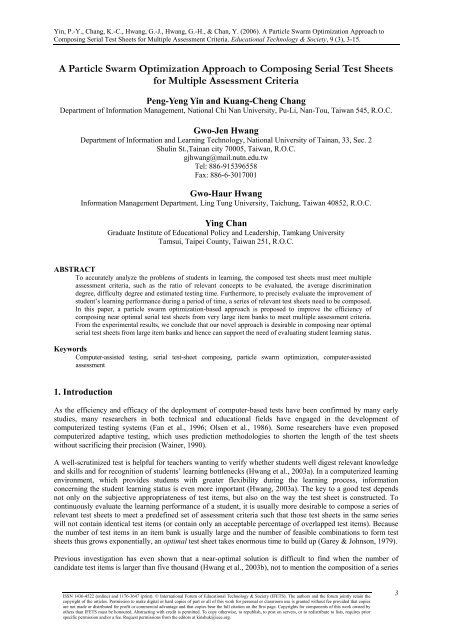July 2006 Volume 9 Number 3 - CiteSeerX
July 2006 Volume 9 Number 3 - CiteSeerX
July 2006 Volume 9 Number 3 - CiteSeerX
Create successful ePaper yourself
Turn your PDF publications into a flip-book with our unique Google optimized e-Paper software.
Yin, P.-Y., Chang, K.-C., Hwang, G.-J., Hwang, G.-H., & Chan, Y. (<strong>2006</strong>). A Particle Swarm Optimization Approach to<br />
Composing Serial Test Sheets for Multiple Assessment Criteria. Educational Technology & Society, 9 (3), 3-15.<br />
A Particle Swarm Optimization Approach to Composing Serial Test Sheets<br />
for Multiple Assessment Criteria<br />
Peng-Yeng Yin and Kuang-Cheng Chang<br />
Department of Information Management, National Chi Nan University, Pu-Li, Nan-Tou, Taiwan 545, R.O.C.<br />
Gwo-Jen Hwang<br />
Department of Information and Learning Technology, National University of Tainan, 33, Sec. 2<br />
Shulin St.,Tainan city 70005, Taiwan, R.O.C.<br />
gjhwang@mail.nutn.edu.tw<br />
Tel: 886-915396558<br />
Fax: 886-6-3017001<br />
Gwo-Haur Hwang<br />
Information Management Department, Ling Tung University, Taichung, Taiwan 40852, R.O.C.<br />
Ying Chan<br />
Graduate Institute of Educational Policy and Leadership, Tamkang University<br />
Tamsui, Taipei County, Taiwan 251, R.O.C.<br />
ABSTRACT<br />
To accurately analyze the problems of students in learning, the composed test sheets must meet multiple<br />
assessment criteria, such as the ratio of relevant concepts to be evaluated, the average discrimination<br />
degree, difficulty degree and estimated testing time. Furthermore, to precisely evaluate the improvement of<br />
student’s learning performance during a period of time, a series of relevant test sheets need to be composed.<br />
In this paper, a particle swarm optimization-based approach is proposed to improve the efficiency of<br />
composing near optimal serial test sheets from very large item banks to meet multiple assessment criteria.<br />
From the experimental results, we conclude that our novel approach is desirable in composing near optimal<br />
serial test sheets from large item banks and hence can support the need of evaluating student learning status.<br />
Keywords<br />
Computer-assisted testing, serial test-sheet composing, particle swarm optimization, computer-assisted<br />
assessment<br />
1. Introduction<br />
As the efficiency and efficacy of the deployment of computer-based tests have been confirmed by many early<br />
studies, many researchers in both technical and educational fields have engaged in the development of<br />
computerized testing systems (Fan et al., 1996; Olsen et al., 1986). Some researchers have even proposed<br />
computerized adaptive testing, which uses prediction methodologies to shorten the length of the test sheets<br />
without sacrificing their precision (Wainer, 1990).<br />
A well-scrutinized test is helpful for teachers wanting to verify whether students well digest relevant knowledge<br />
and skills and for recognition of students’ learning bottlenecks (Hwang et al., 2003a). In a computerized learning<br />
environment, which provides students with greater flexibility during the learning process, information<br />
concerning the student learning status is even more important (Hwang, 2003a). The key to a good test depends<br />
not only on the subjective appropriateness of test items, but also on the way the test sheet is constructed. To<br />
continuously evaluate the learning performance of a student, it is usually more desirable to compose a series of<br />
relevant test sheets to meet a predefined set of assessment criteria such that those test sheets in the same series<br />
will not contain identical test items (or contain only an acceptable percentage of overlapped test items). Because<br />
the number of test items in an item bank is usually large and the number of feasible combinations to form test<br />
sheets thus grows exponentially, an optimal test sheet takes enormous time to build up (Garey & Johnson, 1979).<br />
Previous investigation has even shown that a near-optimal solution is difficult to find when the number of<br />
candidate test items is larger than five thousand (Hwang et al., 2003b), not to mention the composition of a series<br />
ISSN 1436-4522 (online) and 1176-3647 (print). © International Forum of Educational Technology & Society (IFETS). The authors and the forum jointly retain the<br />
copyright of the articles. Permission to make digital or hard copies of part or all of this work for personal or classroom use is granted without fee provided that copies<br />
are not made or distributed for profit or commercial advantage and that copies bear the full citation on the first page. Copyrights for components of this work owned by<br />
others than IFETS must be honoured. Abstracting with credit is permitted. To copy otherwise, to republish, to post on servers, or to redistribute to lists, requires prior<br />
specific permission and/or a fee. Request permissions from the editors at kinshuk@ieee.org.<br />
3

















